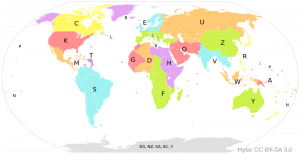With more than 40,000 airports existing in the world, an identification system is required that will serve to unequivocally identify each airport, differentiating it from the rest. The IATA and ICAO aerodrome identification codes serve this purpose. However, although they are used to designate the same airport, there is no relationship between them and they have some differences.
The IATA and ICAO aerodrome identification codes serve the same purpose. However, there is no relationship between them and they have some differences.
The IATA code is perhaps the most well-known airport code and the one most used by passengers, because it is the one that appears on plane tickets, boarding passes, baggage labels and information displays at airports. This code is decided by the International Air Transport Association (IATA).
IATA codes consist of a three-letter code that is usually related to the city or region served by the airport, or the name of the aerodrome that existed before the creation of the airport. However, it does not necessarily include geographic information. Two examples are Malaga Airport (AGP: Malaga-Costa del Sol airport) and Heathrow (LHR: the main airport in London).
Since the code contains only three letters, the possible combinations are limited and consequently the IATA codes are not unique in some cases, with the same code used to designate two different airports. Therefore, the ICAO codes were created because aviation requires a unique designation for airports.
 The ICAO codes are designated by the International Civil Aviation Organization (ICAO) and are used by aviation “professionals” of the aeronautical transport sector (controllers, pilots, etc.), but in general they are not as well known to passengers.
The ICAO codes are designated by the International Civil Aviation Organization (ICAO) and are used by aviation “professionals” of the aeronautical transport sector (controllers, pilots, etc.), but in general they are not as well known to passengers.
They consist of a four-letter code and are often used by more specialised staff due to their uniqueness (no code designates more than one airport), since due to their structure they contain geographic information about the aerodrome.
The first letter of an airport’s ICAO code designates the geographical area where it is located:
 The second letter of the ICAO code indicates, within the geographical area indicated by the first letter, the country where it is found:
The second letter of the ICAO code indicates, within the geographical area indicated by the first letter, the country where it is found:
The third and fourth letters of the code are used to identify the airport in question.
As always, there are slight exceptions: Canada, the United States and Australia are considered as ICAO areas in themselves due to their large size, and therefore the last three letters of their codes serve to define the aerodrome.
If we take as examples the two airports previously referred to, in the case of Malaga airport, the code is LEMG, whereas London Heathrow’s code is EGLL.



